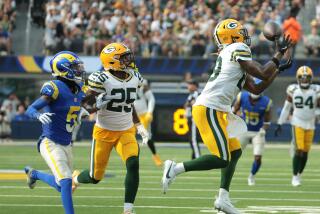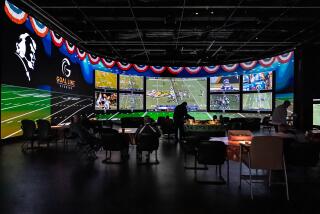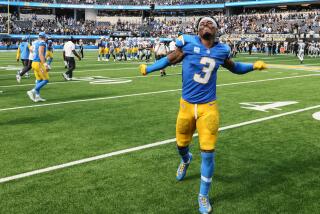PRO FOOTBALL / BOB OATES : Marinovich--but Not Raiders--Played a Winning Game
Coach Art Shell of the Raiders made the right decision last week--presumably with some input from owner Al Davis--when he started 22-year-old rookie quarterback Todd Marinovich in a playoff game at Kansas City.
Marinovich seems to have the required talent. But an inexperienced kid has to be imaginatively handled in a big game, and thatŌĆÖs hard to do. He wasnŌĆÖt, and so the day was lost, 10-6.
Next question: How much will a four-interception defeat affect a young quarterback? That is, how much will he blame himself?
In the most revealing quote of the weekend, Marinovich, after the crushing ordeal, said: ŌĆ£IŌĆÖll never forget this one.ŌĆØ
Who could? And if he tries, heŌĆÖll be reminded everywhere he goes next year. Indefinitely, he will be Four-INT Marinovich.
Psychologically, thatŌĆÖs a load.
To be effective in 1992, Marinovich will have to understand that he bears hardly any responsibility for the 0-2 end of the season.
The Raider defense lost the first one, the Raider organization the second. Both days, Marinovich played winning football.
Care and feeding: When Bill Parcells was coaching the New York Giants in the early 1980s, he showed how to handle a young quarterback: He refused to put Phil Simms in position to be a loser.
Whenever Parcells had two choices--blow the game or blow SimmsŌĆÖ psyche--he made the overly conservative calls that led, sometimes, to defeat.
Thus, in an even game, Parcells never allowed Simms to throw a third-down pass on the GiantsŌĆÖ half of the field. In a close game, he called no high-risk plays. And in time, cultivating Simms carefully, Parcells had a Super Bowl passer.
The care and feeding of young NFL quarterbacks is tricky. If the Raiders ever get another one, their experience this time--when they did most of it incorrectly--should teach them. The proper agenda:
--Above all, donŌĆÖt set a kid up to be destroyed.
--Plan to pass only on running downs.
--DonŌĆÖt call long third-down passes in a tie game. On the Tuesday before the game, a little thought will turn up countless reasonable alternatives to such plays: a quick draw, a fake-draw screen pass, a quick trap, etc.
--Know the plays that arenŌĆÖt going to be called under any circumstances with a rookie passer unless, near the end, a gamble is needed.
--DonŌĆÖt take a young quarterback out of the offense in the third quarter--as the Raiders did Saturday, when they ran the ball so often that Marinovich had to warm up on the sideline--and then send him back in to win it with a cold hand in the fourth quarter.
--Call Parcells.
The four interceptions: Is an NFL interception always the passerŌĆÖs fault? ThatŌĆÖs one way to ask the question. HereŌĆÖs another way: Is it ever his fault?
The answer in both cases is, basically, no.
NFL starters from John Elway to Ken OŌĆÖBrien--and on even to next SundayŌĆÖs pair in Detroit, Steve Beuerlein and Erik Kramer--can throw a football so accurately that a miss is almost always triggered by others: by the coaches who designed or called the play, by the receiver, by a pass rusher when a block is missed, by a defensive back, by the other teamŌĆÖs coach.
The Marinovich accuracy is similar. Accordingly, most coaches, studying Raider tapes during the off-season, can be expected to absolve him of most of the Kansas City blame. He threw two kinds of interceptions there:
--The first two, during the first half, were third-down passes launched from inside the Raider 35 in a game that was scoreless. So, those plays should never have been sent in to a young quarterback. When your defensive team has a game in hand, why throw it away? Why make a hero of Deron Cherry?
--MarinovichŌĆÖs other interceptions, thrown during the fourth quarter when the Chiefs held a 10-6 lead, were deflected from Raiders Tim Brown and Ethan Horton to Kansas City players.
Both times, the ball was thrown too high. But if it canŌĆÖt be caught, it should be blocked. The first responsibility of a receiver under a high pass is to keep the ball from going through--to stop it. A tipped pass is, too often, an intercepted pass.
Plenty of smarts: Some are asking this about the Raiders: Are they making good use of all the brains on their coaching staff?
At least two of ShellŌĆÖs assistants have the talent and experience to be winning NFL head coaches:
--Mike White. In his 30 years in football, White has played end at California, worked with Bill Walsh, led Illinois to the Rose Bowl and coached Marinovich and Jay Schroeder, among others.
--Tom Walsh. After 20 years in football, Walsh, formerly head coach at U.S. International University in San Diego, has become known as one of the gameŌĆÖs leading offensive strategists.
In a year of many NFL job openings, the pro football owner who doesnŌĆÖt interview White and Walsh is short-changing himself.
Both work on the offensive side at El Segundo, where their exact functions are disguised in the secrecy that Davis prefers.
One thing seems reasonably clear, however: They donŌĆÖt have much to do with Raider planning.
Capable of more: As an organization, the Raiders need Art Shell. He provides the team with stability and character. On the job, he isnŌĆÖt as bombastic as Parcells, but Shell gives his players precisely the same sense of character and class.
ItŌĆÖs also true that Shell needs a full-time offensive coordinator. Even though Davis hates titles, the Raiders, if they are ever going to win a fourth-decade Super Bowl, will have to delegate some authority to a clever offensive coordinator such as Sam Wyche or Mike Shanahan or Mike White or Tom Walsh.
A real offensive coach could count on one thing next year--a quarterback with a remarkable football presence for one of MarinovichŌĆÖs age. In the second quarter Saturday, for example, after throwing two interceptions and after fumbling the ball away, Marinovich calmly threw the big passes on the big drive that helped move the Raiders to the Kansas City 20.
There, a Raider jumped offside. There, they gave the ball to a running back on first and 15, and again on second down--guaranteeing that on third down, Marinovich would be blitzed.
He and his teammates were capable of far, far more.
Four rips: In the four games next weekend, the NFLŌĆÖs eight second-round opponents will all have played in the same kind of regular-season happening.
All eight teams either beat up or were beaten up this year by the teams they are about to play again. The log:
--The Washington Redskins, who open the program Saturday against Atlanta, ripped the Falcons, 56-17, two months ago at RFK Stadium.
--The Denver Broncos, who will be visited by Houston, were ripped by the Oilers, 42-14, at the Astrodome in October.
--The Buffalo Bills, who have a rematch with Kansas City Sunday, were ripped by the Chiefs, 33-6, at Arrowhead Stadium in October.
--The Detroit Lions, who will see Dallas again Sunday, ripped the Cowboys, 34-10, at the Silverdome in late October.
Quote Dept.:
--Sean Jones, Houston defensive end, who said he has undergone AIDS testing regularly since his days as a Raider : ŌĆ£For my peace of mind. . . . We donŌĆÖt want to get to the point (in the NFL) where all players are wearing rubber gloves.ŌĆØ
--Roger Headrick, Minnesota Viking president, on the decision by the 10-man Headrick-Mike Lynn group to buy out co-owners Carl Pohlad and Irwin Jacobs for $50 million: ŌĆ£WeŌĆÖre all damned happy.ŌĆØ
More to Read
Go beyond the scoreboard
Get the latest on L.A.'s teams in the daily Sports Report newsletter.
You may occasionally receive promotional content from the Los Angeles Times.










